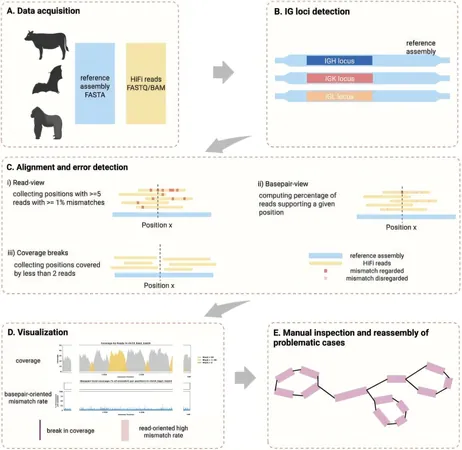
Revolutionizing Genome Sequencing: A Breakthrough Tool for Decoding Complex DNA
2025-06-12
Author: John Tan
Unlocking the Secrets of Our DNA
In a groundbreaking advancement over the last decade, researchers have made significant strides in unraveling the intricate web of genetic instructions that govern life. Despite being closer than ever to achieving perfect genome sequencing accuracy, persistent challenges remain, especially in deciphering the more complex regions of our DNA.
The Challenge of Complex Genome Regions
Certain parts of the genome—characterized by their intricate variations and convoluted replications—continue to evade reliable automatic sequencing. This complexity often necessitates exhaustive manual analysis, which is both time-consuming and costly.
Introducing CloseRead: A Game-Changing Tool
Enter 'CloseRead', a newly developed algorithm co-led by esteemed faculty from the Penn State School of Electrical Engineering and Computer Science. This innovative tool was engineered to streamline the analysis of intricate DNA sections, specifically those responsible for an organism's immune responses.
High Accuracy in a Sea of Complexity
In tests involving 74 publicly available genomes, CloseRead outperformed existing verification tools, particularly in error detection within these complex genomic regions. The findings were recently published in Genome Biology.
Decoding the Genetic Blueprint
Mammalian genomes, made up of billions of nucleotides, pose a formidable challenge for researchers. As Anton Bankevich, assistant professor at Penn State, explained, sequencing a genome is akin to reading a book with microscopic text. While algorithms can help assemble smaller subsequences into a complete genetic picture, errors can slip through the cracks during this reconstruction process.
The Complexity of Diploid Organisms
Adding to this challenge is the fact that mammals inherit two sets of genetic information from both parents, complicating their already massive genomic structure.
Advancements in Sequencing Technology
Since the first human genome was sequenced in 2001 using rudimentary methods, the field has evolved dramatically with the advent of long-read sequencing technology, allowing scientists to analyze larger segments of DNA with incredible accuracy.
Spotlighting Gene Variations and Immunology
Yana Safonova, another co-author of the study, highlighted how long-read sequencing has triggered a surge in mammalian genome data generation. This development is pivotal, enabling scientists to explore connections between an organism's genetic makeup and its health traits, such as disease resistance.
A Deeper Dive into Immunoglobulin Loci
The CloseRead tool specifically focuses on the immunoglobulin (IG) loci, a critical region that shapes our immune responses by enabling the production of antibodies. Safonova pointed out the inherent complexity of this region, laden with repetitive sequences that vary from one individual to another, making it particularly challenging to analyze.
Detecting Errors and Incompleteness
During their examination of the IG loci across 61 mammals and 13 reptiles, the researchers found alarming levels of incompleteness; nearly 50% of assemblies were identified as flawed. Surprisingly, while one copy of genetic material might be assembled correctly, its counterpart could be entirely missing.
Potential Impact on Health and Genetics
Understanding the IG loci is crucial, as it plays a vital role in immunity and disease susceptibility. Insights drawn from this research not only enhance immunogenomics but could also fuel advancements across genetics and biology.
Implications for Species and Evolution
The studies conducted further illuminate species’ genetic histories. For instance, reviewing the Greenland wolf's genome revealed assembly irregularities that ultimately confirmed its ancestral crossbreeding with gray wolves.
The Future of Genome Analysis
Though designed to tackle the complexities of the IG loci, CloseRead holds promise for broader applications in genetics, potentially aiding the study of other intricate genome regions like the elusive Y-chromosome. However, as Bankevich cautioned, while the tools we have are powerful, they are still not perfect. Careful analysis remains critical as the field advances toward a new era of genome sequencing.



 Brasil (PT)
Brasil (PT)
 Canada (EN)
Canada (EN)
 Chile (ES)
Chile (ES)
 Česko (CS)
Česko (CS)
 대한민국 (KO)
대한민국 (KO)
 España (ES)
España (ES)
 France (FR)
France (FR)
 Hong Kong (EN)
Hong Kong (EN)
 Italia (IT)
Italia (IT)
 日本 (JA)
日本 (JA)
 Magyarország (HU)
Magyarország (HU)
 Norge (NO)
Norge (NO)
 Polska (PL)
Polska (PL)
 Schweiz (DE)
Schweiz (DE)
 Singapore (EN)
Singapore (EN)
 Sverige (SV)
Sverige (SV)
 Suomi (FI)
Suomi (FI)
 Türkiye (TR)
Türkiye (TR)
 الإمارات العربية المتحدة (AR)
الإمارات العربية المتحدة (AR)